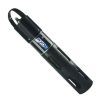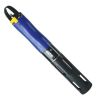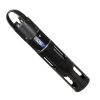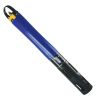YSI EXO NitraLED UV Nitrate Sensor
Features
- Available at a fraction of the cost of other lamp-based nitrate sensors
- Built-in corrections for natural organic matter (NOM) and turbidity
- Designed for use with EXO1, EXO2, EXO3, or EXO2s water quality sondes
- Expedited repair and warranty service
- Lifetime technical support
- More
| Accuracy (0-10mg/L) |
± 0.1 mg/L–N or 5% of reading, w.i.g. (within 2°C) |
|---|---|
| Accuracy (10-30mg/L) |
± 7% of reading |
| Depth Rating | 250 m |
| Drift / Stability |
≤ 0.2 mg/L–N |
| Equipment used with | EXO™ |
| Light Source | UV LED (x2) |
| Lower Detection Limit |
0.005 mg/L–N |
| Measurement Range |
0-30 mg/L–N |
| Medium |
Fresh water |
| Nominal Wavelengths | 235 nm, 275 nm |
| Operating Temperature | 5-35°C |
| Pathlength | 10 mm |
| Precision |
≤ 2% Coefficient of Variation (CV) |
| Response Time | T95 < 30 seconds |
| Sensor | Optical, absorbance |
| Storage Temperature | -20-80 °C |
| Warranty |
2 years |
- YSI EXO NitraLED UV Nitrate Sensor Specifications
- YSI EXO NitraLED UV Nitrate Sensor Handbook
- YSI EXO NitraLED UV Nitrate Sensor Corrections for Turbidity and NOM
- YSI EXO NitraLED UV Nitrate Sensor Site Specific Correction Procedure
- YSI EXO NitraLED UV Nitrate Sensor Installation Guide
- YSI EXO Water Quality Sonde Specifications
- YSI EXO Water Quality Sonde Manual
In The News
Sewage an Unseen and Ignored Threat to Coral Reefs and Human Health
It’s an open, dirty secret that the ocean is used as the ultimate sewage solution. Each year trillions of gallons of untreated waste are sent to the ocean due to a widespread lack of sanitation technology or infrastructure that needs updating as cities and populations grow. As the impact of untreated sewage on the ocean becomes clearer, attention to the problem and strategies for dealing with it have not kept up. “This is a massive problem and it’s been largely ignored,” said Stephanie Wear, senior scientist and strategy advisor for The Nature Conservancy. Wear has turned her attention to raising the alarm about the effects of sewage on coral reefs, which often loses airtime to other pressing issues like climate change and overfishing.
Read MoreSource Water Monitoring in Albany, New York: Tracing Water Quality throughout Tributaries
Thousands of US cities pull their drinking water from natural source waters like reservoirs, rivers, and streams, making overall watershed health a key consideration for water providers. In Albany, New York, the Albany Department of Water and Water Supply delivers drinking water to over 100,000 residents as well as monitors and manages the larger drinking water supply watershed. Hannah Doherty, Environmental Specialist at the Albany Department of Water and Water Supply , spends her days working with a small team to monitor the drinking supply and the connected water bodies. Doherty explains, “We’re the first to encounter the water that ends up being the drinking water.
Read MoreWildfire Prevention in the Sierra Nevada Region with the Yuba Watershed Institute
Though recent wildfires have sparked new conversations about wildfire management and response, groups like the Yuba Watershed Institute have been monitoring the forests and water resources of the Sierra Nevada region for decades, managing approximately 5,000 acres of land with the Bureau of Land Management (BLM) and about 7,000 acres in private land partnerships. The goal of the Institute is to work with local communities and land agencies to improve watershed and forestry management through informed practices and public outreach. The goals of the Yuba Watershed Institute are three-fold: Improve the ability of fire suppression agencies like the California Department of Forestry and Fire Protection ( CAL FIRE ) and the US Forest Service.
Read More















